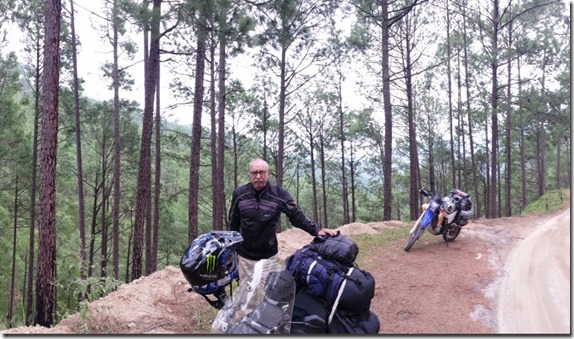Regular readers of Parsi Khabar will remember Noshir Mistry and his amazing video motorcycling in Ladakh.
This month Nosh and his dad are on an epic motorcycle ride through North India, on two different motorcycles. Below is his first post.
Nosh writes
I was born in the Indian state of Bihar. Today it is one of the poorest states in India, yet in terms of a concentration of mineral resources is one of the richest in the world.
It is a state that saw the birth of ‘The Buddha’ where he travelled by foot delivering his sermons and teachings. It was also home to The Nalanda University in the 6th century BC which was the centre of world learning at its time. The town I was born in was Jamshedpur. It is where the famous Tata family built India’s first Iron and steel plant. Today they have journeyed worldwide to own brands like Landrover, Jaguar, Tetleys and many more.
Keen to understand how and why these seeming contradictions coexist in the same state, I undertook frequent motorbike trips with my father for outings into the surrounding villages to photograph life as it existed. The seeds were sown. These trips were on a 1956 Norton dominator motorbike which was also the family vehicle where I would ride on the fuel tank at the front, followed by my father riding the bike, my mother sitting sideways with my sister on her lap. Being India, ofcourse none of us wore helmets. Even a commute was an adventure. Once I learned to ride my bicycle at 4, my father encouraged and allowed me to steer the bike for short periods when the roads were clear. Weekend trips into nature were a highlight and we would happily wash the family mule in exchange for a ride. Watching the Smiths Chronometer jump from 40 to 65 miles an hour under acceleration and feel the literal wind on our faces was exhilarating, until a bug splattered against your face. Relative velocity is a powerful force.
In 1995, my father and I rode across India on a restored 1956 Triumph speed twin. The old technology was reliable, but had its glitches. On our first attempt, we had to push the bike back only a few km from home, the engine had semi-seized. Back to the garage, engine opened and examined, a faulty oil pressure spring was to blame. That fixed, we ran the bike stationary with pedestal fans pointing at the air cooled engine. 3 days later, we were off. 1800 km across India, trying to read a flapping paper map at 90 kmph, dodging dogs, cattle, traffic, people and even birds, finding and asking our way across innumerable villages and towns in India – probably the best way to make contact with locals who had no idea of left from right – we had crossed India from the right to the left.
20 years later it is now 2015. Dad has turned 70 this year and we are both travelling on our own motorbikes into the Himalayas for over 7 weeks. Just mates doing something we have both always wanted to do. We will be covering over 5000 km and I will also be taking part in the world’s highest motorsport event – The Raid de Himalaya – a 6 day – 2000 km rally across the Himalayas. Not on heavy old British bikes which ooze character, we have chosen smaller bikes. Dad a 160cc Honda and me a Yamaha WR250R. Perhaps the right bike for me as Yama means Mountain and Ha means leaf in Japanese. The logo for Yamaha – 3 tuning forks – comes from the heritage of its origins in making musical instruments. Ironically the first instrument was harshly criticized for its poor tuning. Undaunted, and starting from zero, its founder Torakusu Yamaha began his journey studying music theory and tuning. After four months of seemingly endless struggles from early morning to late at night, he was finally able to complete the organ. It is easy to see how he came up with the concept of the tuning fork mark.
I will then be riding across from the North of India towards the East. My wife joins me here and we ride into Mynmar, entering Thailand where our 10 year old daughter joins us, then through to Laos, Vietnam, Cambodia, Malaysia and finally Singapore from where I will ship my bike to Darwin and ride back to Sydney. I will still be using paper maps and asking for directions for the most part, but unlike riding on the fuel tank from days of old, I will be on a seat and also have my helmet on.
In Basho’s haiku – Every day is a journey, and the journey itself is home.
From trying to understand life and its challenges to simply observing and accepting things in their entirety, on my travels, I follow a simple code – say ‘Yes’ to everything. It is a time to leave your old self aside. You are in a new environment, with new people, in new places, interacting with new cultures, engaging new ways of thinking, why experience it in an old way? Why not drop yourself and explore where it leads to.
We want our ventures and adventures to be life changing? Yet we want that change to be predictable, we hanker for that change to be predictable. Change by its very nature is unpredictable. Life with its everyday intricacies is every changing. We want to be renewed without losing our old selves. Is that even possible? Rephrasing Basho, Life is a journey and the journey is life. As we all know – motorbikes move the body and sometimes the soul. In my experience, the greatest ‘outward’ journeys are the ones which take you deepest ‘inwards’.
I would love to share this adventure here. The journey starts 5th September.
You can continue reading and follow the journey on ADVRider



